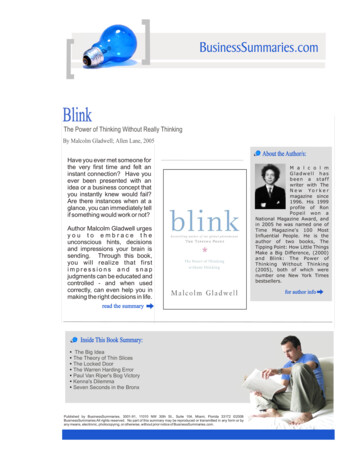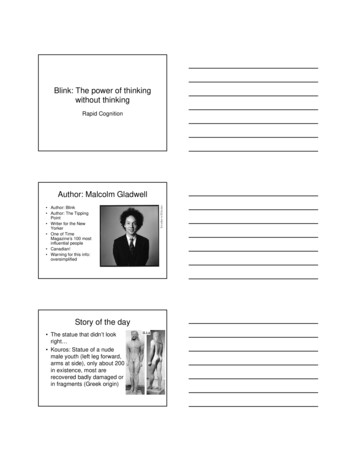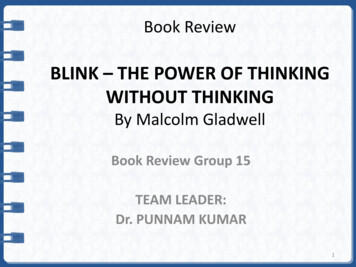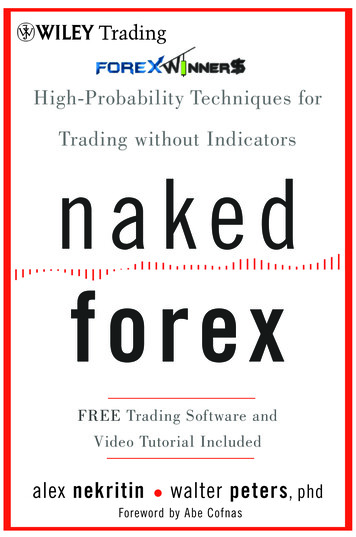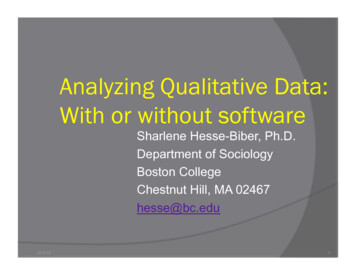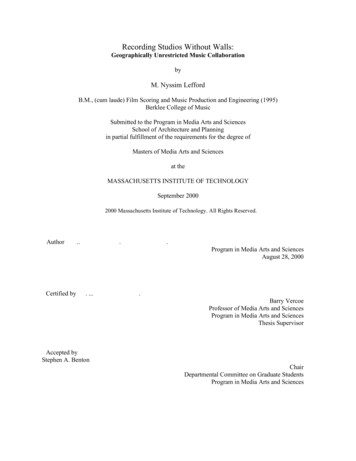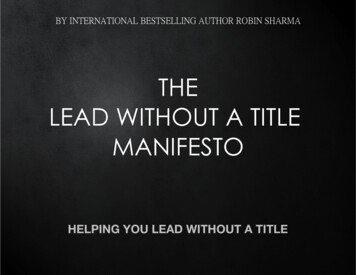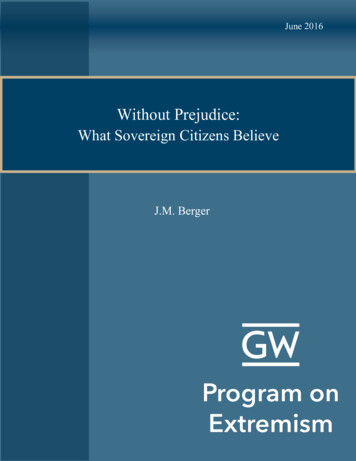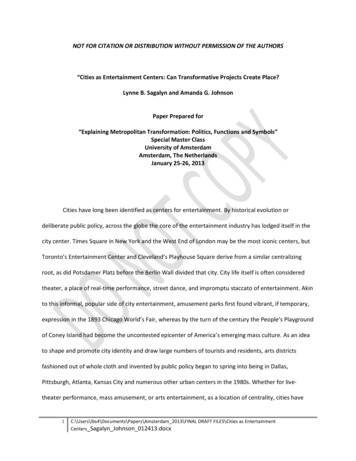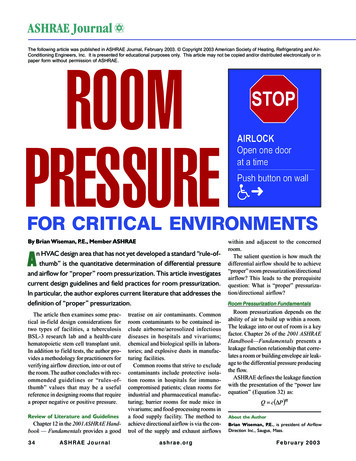
Transcription
Concentrated Knowledge for the Busy Executive www.summary.comVol. 27, No. 6 (2 parts), Part 1, June 2005 Order # 27-14The Power of Thinking Without ThinkingBLINKTHE SUMMARY IN BRIEFBy Malcolm GladwellCONTENTSThe Statue That Didn’tLook RightPages 2, 3The Locked Door: The SecretLife of Snap DecisionsPages 3, 4The Storytelling ProblemBlink is about how we think without thinking, about choices that seemto be made in an instant — in the blink of an eye — that actually aren’t assimple as they seem, and about those instantaneous decisions that areimpossible to explain to others.Blink reveals that great decision makers aren’t those who process themost information or spend the most time deliberating, but those who haveperfected the art of “thin-slicing” — filtering the very few factors that matter from an overwhelming number of variables.In his landmark bestseller, The Tipping Point, author MalcolmGladwell redefined how we understand the world around us. Now, in Blink,he revolutionizes the way we understand the world within by exploring thedecisions made by experts in museums, sales, sports, the military and thehigh-speed world of the New York Mercantile Exchange.Drawing on cutting-edge neuroscience and psychology, and displayingall of the brilliance that made The Tipping Point a classic, Blink changesthe way you understand every decision you make.Never again will you think about thinking the same way.Page 4The Dark Side of Thin-SlicingPages 4, 5Harnessing Thin-SlicingPage 5Verbal OvershadowingPage 6Insight PuzzlesPages 6, 7Market ResearchPage 7Expert TestimonyPages 7, 8The Naked FacePage 8What You’ll Learn In This Summary How unique but learnable skills can empower human perception andunderstanding. Why some people are brilliant decision makers. Why some people follow their instincts and win, while others end upstumbling into error. How our brains really work — in the office, in the classroom and in themarketplace. Why some snap decisions have better results than those we agonize over. How some of the best decision makers utilize the theory of thin-slicing totheir competitive advantage. Why snap decisions are so important. How training and practice can affect our ability to make the right decision. How to read minds by watching facial movements.Practice Makes PerfectPage 8Published by Soundview Executive Book Summaries, P.O. Box 1053, Concordville, Pennsylvania 19331 USA 2005 Soundview Executive Book Summaries All rights reserved. Reproduction in whole or part is prohibited.FILE: LEADERSHIP
BLINKby Malcolm Gladwell— THE COMPLETE SUMMARYThe Statue That Didn’tLook RightIn September 1983, an art dealer by the name ofGianfranco Becchina approached the J. Paul GettyMuseum in California. He had in his possession, hesaid, a marble statue dating from the 6th century B.C. Itwas what is known as a kouros — a sculpture of a nudemale youth standing with his left leg forward and hisarms at his sides. There are only about 200 kouroi inexistence, and most have been recovered badly damagedor in fragments from grave sites or archeological digs.But this one was almost perfectly preserved. It stoodclose to 7 feet tall. It had a kind of light-colored glowthat set it apart from other ancient works. It was anextraordinary find. Becchina’s asking price was justunder 10 million.Core Sample FindingsThe Getty moved cautiously. It took the kouros onloan and began a thorough investigation. A geologistfrom the University of California named StanleyMargolis came to the museum and spent two daysexamining the surface of the statue with a high-resolution stereomicroscope. He then removed a core samplefrom just below the right knee and analyzed it using anelectron microscope, electron microprobe, mass spectrometry, X-ray diffraction and X-ray fluorescence.The statue was made of dolomite marble from theancient Cape Vathy quarry on the island of Thasos,Margolis concluded, and the surface of the statue wascovered in a thin layer of calcite — which was significant, Margolis told the Getty, because dolomite can turninto calcite only over the course of hundreds, if notthousands, of years. In other words, the statue was old.It wasn’t some contemporary fake.The Getty was satisfied. Fourteen months after itsinvestigation of the kouros began, it agreed to buy thestatue. In the fall of 1986, the statue went on display forthe first time.A ProblemThe kouros, however, had a problem. It didn’t lookright. The first to point this out was an Italian art historian named Federico Zeri, who served on the Getty’sThin-Slicing DefinedA critical part of rapid cognition is known as “thinslicing.” Thin-slicing refers to the ability of ourunconscious mind to find patterns in situations andbehavior based on very narrow slices of experience.In the theory of thin slices, a little bit of knowledgegoes a long way. Thin-slicing is part of what makesthe unconscious so dazzling.This is the way that our unconscious works: It issifting through the situation in front of us, throwingout all that is irrelevant while we zero in on whatreally matters. The truth is that our unconscious isreally good at this, to the point where thin-slicingoften delivers a better answer than more deliberateand exhaustive ways of thinking. Thin-slicing is notan exotic gift. It is a central part of what it means tobe human. We thin-slice whenever we meet a newperson, have to make sense of something quickly orencounter a novel situation.board of trustees. When he was taken down to the museum’s restoration studio to see the kouros in December1983, he found himself staring at the sculpture’s fingernails. In a way he couldn’t immediately articulate, theyseemed wrong to him.Evelyn Harrison, one of the world’s foremost expertson Greek sculpture, was next. What did Harrison see?She didn’t know. In the very first moment of seeing the(continued on page 3)The author: Malcolm Gladwell is a staff writer for theNew Yorker. He was formerly a business and sciencereporter at the Washington Post. He was born in England,raised in Canada, and now lives in New York City.Copyright 2005 by Malcolm Gladwell. Summarizedby permission of the publisher, Little, Brown and Co.(Inc.), New York, NY. All rights reserved. 277 pages. 25.95. 0-316-17232-4.Summary Copyright 2005 by Soundview ExecutiveBook Summaries. www.summary.com, 1-800-SUMMARY,1-610-558-9495.For additional information on the author,go to: http://my.summary.comPublished by Soundview Executive Book Summaries (ISSN 0747-2196), P.O. Box 1053, Concordville, PA 19331USA, a division of Concentrated Knowledge Corp. Published monthly. Subscriptions: 195 per year in the UnitedStates, Canada and Mexico, and 275 to all other countries. Periodicals postage paid at Concordville, PA and additionaloffices.Postmaster: Send address changes to Soundview, P.O. Box 1053, Concordville, PA 19331. Copyright 2005 bySoundview Executive Book Summaries.Available formats: Summaries are available in print, audio and electronic formats. To subscribe, call us at1-800-SUMMARY (610-558-9495 outside the United States and Canada), or order on the Internet at www.summary.com.Multiple-subscription discounts and corporate site licenses are also available.2Soundview Executive Book Summaries SoundviewExecutive Book Summaries GREER MCPHERSON – Contributing EditorDEBRA A. DEPRINZIO – Senior Graphic DesignerCHRIS LAUER – Senior EditorCHRISTOPHER G. MURRAY – Editor in ChiefGEORGE Y. CLEMENT – Publisher
Blink — SUMMARYThe Statue That Didn’t Look RightSnap Decisions in Sports(continued from page 2)statue, all Harrison had was a hunch, an instinctivesense that something was amiss.A few months later, Thomas Hoving, the formerdirector of the Metropolitan Museum of Art in NewYork, was taken down to the Getty’s conservation studioto see the statue as well. Hoving always makes a note ofthe first word that goes through his head when he seessomething new, and he’ll never forget what that wordwas when he first saw the kouros. “It was ‘fresh’ —‘fresh,’” Hoving recalls. And “fresh” was not the rightreaction to have to a 2,000-year-old statue.Cold FeelingsWhen George Despinis, the head of the AcropolisMuseum in Athens, took one look at the kouros heblanched. “Anyone who has ever seen a sculpture coming out of the ground,” he said, “could tell that thatthing has never been in the ground.” And later, GeorgiosDontas, head of the Archeological Society in Athens,saw the statue and immediately felt cold. “When I sawthe kouros for the first time,” he said, “I felt as thoughthere was a glass between me and the work.”Further investigations revealed more questions aboutthe statue’s authenticity. Now, in the Getty catalog, thereis a picture of the kouros, with the notation “About 530B.C., or modern forgery.”When Federico Zeri, Evelyn Harrison, ThomasHoving and Georgios Dontas — and many others —looked at the kouros and felt an “intuitive repulsion,”they were absolutely right. In the first two seconds oflooking — in a single glance — they were able tounderstand more about the essence of the statue than theteam at the Getty was able to understand after 14months.This summary is about those first two seconds. The Locked Door: The SecretLife of Snap DecisionsHere is a critical fact about the thoughts and decisionsthat bubble up from our unconscious. Snap judgmentsare, first of all, enormously quick: They rely on thethinnest slices of experience. They are also unconscious.Snap judgments and rapid cognition take place behind alocked door. We are not very good at dealing with thefact of that locked door. It’s one thing to acknowledgethe enormous power of snap judgments and thin slicesbut quite another to place our trust in something soseemingly mysterious.Our world requires that decisions be sourced and foot-Vic Braden, one of the world’s top tennis coaches,has noticed something during his many years of working with some of the world’s best athletes. He hasasked many of these professionals questions aboutwhy and how they play the way they do, and invariablyhe comes away disappointed. “Out of all the researchthat we’ve done with top players, we haven’t found asingle player who is consistent in knowing and explaining exactly what he does,” Braden says. “They give different answers at different times, or they have answersthat simply are not meaningful.” One of the things hedoes, for instance, is videotape top tennis players andthen digitize their movements, breaking them downframe by frame on a computer so that he knows, say,precisely how many degrees Pete Sampras rotates hisshoulder on a cross-court backhand.An Inability to Describe How We BehaveOne of Braden’s digitized videotapes is of the tennis great Andre Agassi hitting a forehand. The imagehas been stripped down. Agassi has been reduced toa skeleton, so that as he moves to hit the ball, themovement of every joint in his body is clearly visibleand measurable. The Agassi tape is a perfect illustration of our inability to describe how we behave in themoment. “Almost every pro in the world says that heuses his wrist to roll the racket over the ball when hehits a forehand,” Braden says. “Why? What are theyseeing? Look,” — and here Braden points to thescreen — “see when he hits the ball? We can tellwith digitized imaging whether a wrist turns aneighth of a degree. But players almost never movetheir wrist at all. Look how fixed it is. He doesn’tmove his wrist until long after the ball is hit. Hethinks he’s moving it at impact, but he’s actually notmoving it until long after impact. How can so manypeople be fooled?”Ted Williams’ Blind SpotBraden found the same problem with the baseballplayer Ted Williams. Williams always said he couldlook the ball onto the bat, that he could track it rightto the point where he made contact. But Bradenknew from his work in tennis that that is impossible.In the final five feet of a tennis ball’s flight toward aplayer, the ball is far too close and moving much toofast to be seen. The player, at that moment, is effectively blind. The same is true with baseball. “I metwith Ted Williams once,” Braden says. “I said, ‘Gee,Ted. We just did a study that showed that humanbeings can’t track the ball onto the bat. It’s a threemillisecond event.’ And he was honest. He said,‘Well, I guess it just seemed like I could do that.’”(continued on page 4)Soundview Executive Book Summaries 3
Blink — SUMMARYThe Locked Door:The Secret Life of Snap Decisions(continued from page 3)noted, and if we say how we feel, we must also be prepared to elaborate on why we feel that way. Thatapproach is a mistake. If we are to learn to improve thequality of the decisions we make, we need to accept themysterious nature of our snap judgments. We need torespect the fact that it is possible to know withoutknowing why we know and accept that — sometimes —we’re better off that way. The Storytelling ProblemOn a brisk spring evening not long ago, two dozenmen and women gathered in the back room of aManhattan bar to engage in a peculiar ritual known asspeed-dating. At the beginning, they mingled awkwardly, clutching their drinks, and then the coordinator of theevening called the group to order.Each man would have six minutes of conversationwith each woman. The women would sit for the duration of the evening against the wall on the long, lowcouches that ringed the room, and the men would rotatefrom woman to woman, moving to the next womanwhenever the coordinator rang a bell signaling that thesix minutes were over. The daters were all given abadge, a number and a short form to complete, with theinstruction that if they liked someone after six minutes,they should check the box next to his or her number. Ifthe person whose box he or she checked also checkedhis or her box, both daters would be notified of theother’s e-mail address within 24 hours.something very strange and troubling happens. Whatonce seemed like the most transparent and pure of thinslicing exercises turns into something quite confusing.Be
Blink — SUMMARY The Statue That Didn’t Look Right (continued from page 2) Soundview Executive Book Summaries Snap Decisions in Sports Vic Braden, one of the world’s top tennis coaches, has noticed something during his many years of work-ing with some of the world’s best athletes. He has asked many of these professionals questions aboutFile Size: 312KBPage Count: 8
